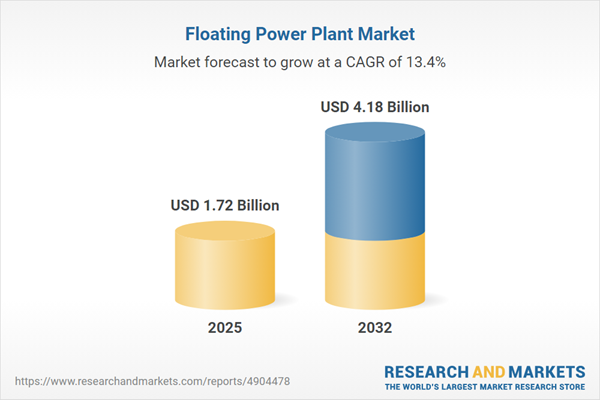Speak directly to the analyst to clarify any post sales queries you may have.
The floating power plant market is transforming energy strategies for enterprises, enabling rapid, mobile power delivery in environments where grid infrastructure is limited or impractical. Senior decision-makers now have viable options to enhance operational resilience and sustainability by adopting these flexible generation solutions.
Market Snapshot: Floating Power Plant Market Growth and Trends
The global floating power plant market is forecast for robust expansion between 2024 and 2032, with growth propelled by industries demanding swift, portable electrification across mature and underserved regions. Investments target assets that guarantee energy autonomy and enhance security, helping organizations navigate physical constraints and regulatory evolution. Implementation is accelerating owing to regulatory incentives, compliance developments, and modernization of aging assets. The integration of digital analytics and monitoring tools is increasing transparency and optimizing performance throughout operational lifecycles. This progress allows floating power plants to serve a broader range of sectors and locations, reinforcing their strategic significance under shifting market and energy policy conditions.
Scope & Segmentation of the Floating Power Plant Market
- Power Source: Solutions encompass floating LNG units, nuclear-powered platforms, offshore wind systems, solar PV arrays, and ocean thermal energy facilities, designed to meet enterprise sustainability targets and regional policies.
- Power Output: Installations are available under 50 MW for niche, remote needs, as well as larger systems to serve commercial and industrial power loads.
- Mooring System: Catenary and taut mooring technologies provide secure anchoring for floating assets in marine and coastal settings, reducing exposure to environmental hazards.
- Installation Type: Options include barge-mounted, semi-submersible, and ship-based platforms, offering adaptability for both short- and long-term deployment requirements.
- Ownership Model: Public and private funding arrangements allow stakeholders to align investments and risk profiles according to market and regulatory objectives.
- End User: Utilities, government bodies, defense, commercial entities, manufacturers, mining, and oil and gas organizations deploy floating power plants to meet varied reliability and flexibility demands.
- Regions: Adoption differs across the Americas, Europe, Middle East & Africa, and Asia-Pacific, each influenced by local energy strategies, infrastructure financing, and environmental measures.
- Key Companies: Market leaders include Bharat Heavy Electricals Limited, Caterpillar Inc., CHN ENERGY Investment Group, Ciel et Terre International, DNV AS, Doosan Heavy Industries & Construction, Equinor ASA, Floating Power Plant A/S, GE Vernova, Hyosung Heavy Industries, Hyundai Heavy Industries, JERA Co., Inc., Karadeniz Holding, Kawasaki Heavy Industries, Mitsubishi Heavy Industries, Ocean Power Technologies, Ocean Sun AS, Shanghai Electric Group, Siemens Energy AG, Swimsol GmbH, Vikram Solar Limited, and Wärtsilä Oyj Abp, contributing advanced technical and deployment capacity.
Key Takeaways for Senior Decision-Makers
- Floating power plants introduce strategic agility, enabling organizations to implement projects where permanent grid solutions are not feasible and thereby fostering operational continuity amid uncertainty.
- A portfolio of technologies, including LNG, solar PV, offshore wind, and nuclear platforms, empowers enterprises to satisfy environmental goals and comply with evolving regulatory standards in diverse environments.
- Modular designs and robust mooring systems offer quick adaptation to shifts in facility requirements or changes in regulatory landscapes, supporting project management flexibility.
- Advanced digital monitoring tools and predictive maintenance protocols enhance asset reliability, minimize unplanned downtime, and streamline resource use across distributed locations.
- Collaborative initiatives among technology, maritime, and engineering providers are facilitating new investment frameworks and faster project turnaround, reinforcing responsiveness to market evolution.
Tariff Impact on Competitive Landscape
In the United States, tariffs on imported floating power plant components are influencing a move toward domestic manufacturing and local sourcing. This development is affecting procurement approaches and prompting providers to emphasize efficiency and disciplined cost management to remain competitive under new regulatory constraints.
Methodology & Data Sources
Insights presented in this floating power plant market research report are grounded in direct interviews with sector specialists and thorough analyses of operational floating power plant implementations. Scenario validation ensures that findings reflect the needs and priorities of industry leadership.
Why This Report Matters
- Clarifies technology adoption paths and opportunities for floating power plants in complex and inaccessible markets.
- Enables proactive management of supply chain, policy, and operational risks to strengthen resilience and adaptability within dynamic environments.
- Guides the refinement of business and investment strategies for competitive advantage as the floating power plant market continues its international progression.
Conclusion
Floating power plants provide enterprises with robust, flexible, and mobile energy solutions, supporting infrastructure resilience and timely energy delivery. Integrating these insights empowers confident, future-focused decision-making during the ongoing energy transformation.
Additional Product Information:
- Purchase of this report includes 1 year online access with quarterly updates.
- This report can be updated on request. Please contact our Customer Experience team using the Ask a Question widget on our website.
Table of Contents
3. Executive Summary
4. Market Overview
7. Cumulative Impact of Artificial Intelligence 2025
Companies Mentioned
The companies profiled in this Floating Power Plant market report include:- Bharat Heavy Electricals Limited
- Caterpillar Inc.
- CHN ENERGY Investment Group Co. LTD
- Ciel et Terre International, SAS
- DNV AS
- Doosan Heavy Industries & Construction Co., Ltd.
- Equinor ASA
- Floating Power Plant A/S
- GE Vernova Inc.
- Hyosung Heavy Industries Corporation
- Hyundai Heavy Industries Co., Ltd.
- JERA Co., Inc.
- Karadeniz Holding
- Kawasaki Heavy Industries, Ltd.
- MITSUBISHI HEAVY INDUSTRIES, LTD.
- Ocean Power Technologies, Inc.
- Ocean Sun AS
- Shanghai Electric Group Co., Ltd.
- Siemens Energy AG
- Swimsol GmbH
- Vikram Solar Limited
- Wärtsilä Oyj Abp
Table Information
| Report Attribute | Details |
|---|---|
| No. of Pages | 197 |
| Published | November 2025 |
| Forecast Period | 2025 - 2032 |
| Estimated Market Value ( USD | $ 1.72 Billion |
| Forecasted Market Value ( USD | $ 4.18 Billion |
| Compound Annual Growth Rate | 13.3% |
| Regions Covered | Global |
| No. of Companies Mentioned | 23 |









